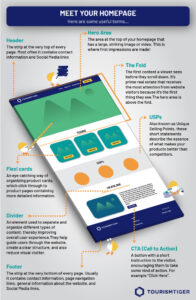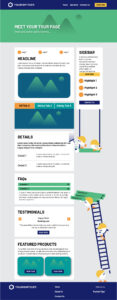There is little doubt that a visually appealing and user-friendly website is the key to capturing the attention of potential customers in the tourism industry. Whether you’re promoting hikes over mountain tops or kayak trips in the scenic valley between the mountain tops, a tour operator can really benefit from understanding the basics of web design for creating an impactful online presence. Our team pride ourselves on walking clients through the process step by step, but with a little basic understanding of design language, it can be much easier for you to visualize each feature along the way. Let’s take a look at some key design concepts and terminology tailored for tourism websites.
Header: Navigating the First Impressions
A strip along the top of the page, that encompasses essential elements such as contact information, social media links, and a company message. It offers users immediate access to key details and establishes a connection with the company’s online presence.
Hero Area: Painting a Picture Worth a Thousand Words
This is the large, visually striking section at the top of your webpage, often featuring breath-taking images or compelling videos that instantly convey what your tours are about. The Hero of your website is the first thing that visitors see, sets the tone for their entire experience and is a great opportunity to communicate your brand identity. Include your logo and a well-thought-out navigation menu. This is definitely ‘prime real estate’ and should be inviting, informative, and begin to tell a story that intrigues your visitors.
images or compelling videos that instantly convey what your tours are about. The Hero of your website is the first thing that visitors see, sets the tone for their entire experience and is a great opportunity to communicate your brand identity. Include your logo and a well-thought-out navigation menu. This is definitely ‘prime real estate’ and should be inviting, informative, and begin to tell a story that intrigues your visitors.
USPs (Unique Selling Points): Standing Out to the Crowd
Your tourism business is unique, and your website should reflect that. Clearly communicating your Unique Selling Points (USPs) on your homepage, specifically – What sets you apart from competitors? Is it personalized service, exclusive destinations, or unbeatable prices? We can help you highlight these distinctive features to gain potential customers’ attention and allow them to envision the value they’ll receive by choosing your tourism services over others.
Flexi Cards: Quick Links to Explore Your Products
Flexi cards, also known as product cards, are clickable images or visuals on your homepage. These cards serve as shortcuts to specific tour or product pages. When visitors click on these cards, they’re swiftly directed to detailed information about a particular offering.
Think of these as visual representations of your different tours or travel packages. These cards are designed to provide a snapshot of what’s available, and users can easily click through to get more details.
Divider: Enhancing Visual Hierarchy
Visual hierarchy is crucial for guiding visitors through your website seamlessly. Dividers help create a sense of order and separation between different sections, improving the overall visual experience. Our designers work with you in the beginning stages to come up with the most appropriate icons and dividers for your website.
Footer: The Final Invitation to Connect
The footer isn’t just a closing note; it’s an invitation to connect with visitors beyond their initial visit and provide a tool for navigating the website. This bottom section of your webpage is home to important links, contact information, and copyright details. In addition to essential links, consider adding social media buttons, encouraging visitors to follow your journeys on platforms like Instagram or Facebook. This allows you to showcase real-time updates, exclusive offers, and community engagement.
The header and footer are the constant companions on your website. The header, always at the top, contains the menu and essential information, ensuring easy navigation. Simultaneously, the footer at the bottom holds important links. These elements stay put, providing a consistent and user-friendly experience, making it effortless for visitors to explore your tourism offerings.
Distinguishing Between Home Page and Product Pages
 Home Page and some of the basic features it should include:
Home Page and some of the basic features it should include:
Hero Area: An eye-catching introduction to your services.
USPs: Clearly stated unique selling propositions.
Flexi Cards: Dynamic cards showcasing key details.
Highlights: Intriguing snippets of your top offerings.
Testimonials: Positive reviews that build trust.
Footer: Essential contact details and links for further exploration.
Tour pages and some of the features it may include:
Header: Consistent branding and navigation for easy exploration.
Headline: Clear and compelling titles for each product.
Primary area: Principal area below the Hero containing enticing, SEO-friendly content about the tour.
Photo(s): High quality images related to the tour.
Divider: Visual separation for easy information digestion.
Sticky Tabs: Persistent navigation for seamless browsing.
FAQs: Address common queries related to specific products.
Featured Products: Highlight related services or add-ons with flexi cards for further exploration.
Footer: Concluding information and calls-to-action for bookings.
By incorporating these design elements effectively, your tourism website can create an immersive and informative experience for visitors, ultimately converting them into enthusiastic customers.
At TourismTiger, we specialize in the art of developing websites for tourism and activity ventures, placing a strong emphasis on essential SEO foundations. Our focus extends to crafting optimized website structures for seamless user navigation, ensuring mobile-friendliness to cater to the needs of today’s travellers. With meticulous attention to detail, we architect each site element, from user-friendly layouts to implementing your preferred booking software. Reach out to us today to explore how we can assist you in bringing your tourism business online, armed with a uniquely crafted, SEO-friendly website.
Find this article useful? Enter your details below to receive your FREE copy of 95 Epic Places To List Your Tours and receive regular updates from Tourism Tiger and leading industry experts.
By submitting this form, you agree to Tourism Tiger contacting you via email.